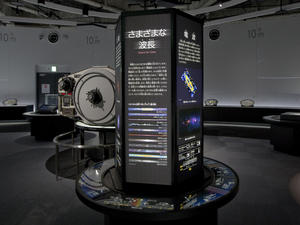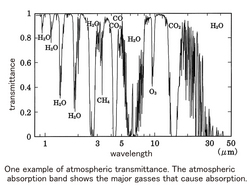Nagoya City Science Museum
TOP > Exhibition Guide > Keyword Search > Starting with "G" > galaxy > Beyond the Visible
Beyond the Visible

Purpose of Exhibition
All objects emit various kinds of light and radiation, and which are collectively called "Electromagnetic Waves." Electromagnetic waves have characteristics of waves. Their form and behavior changes depending on the wavelength; and they are classified according to the wavelength. Hotter bodies universally release shorter wavelengths which have higher energy. Contrarily, the cooler the object, the longer wavelengths and the lower energy it produces. Then, observations at various wavelengths reveal to us another aspect of the Universe.
This exhibit will give you various views of the Milky Way and other galaxies seen in various wavelengths.


Additional Knowledge
[Electromagnetic Waves That Reach the Surface of the Earth, Electromagnetic Waves That Do Not]
Not all electromagnetic waves coming from the Universe can be observed from the surface of the earth. Part of the waves are absorbed by the atmosphere of the earth. The ratio of what reaches the surface to the whole incident upon the earth is called the atmospheric transparency, and is usually expressed as 0 (not reaching at all) to 1 (no absorption in the medium).
For example, transmittance of X rays, Gamma rays and far-infrared rays are always 0, which means that these electromagnetic waves can only be observed using instruments outside the atmosphere, such as astronomical satellites. It was only after rocket technology was established in the latter half of 20th century that their existence became apparent and observable. From an astronomical standpoint it is certainly tough to get above the earth's atmosphere, but since it is opaque to high-energy electromagnetic waves such as X-rays, we can live safely on the surface of the earth.
The atmospheric transparency fluctuates depending on the weather conditions; visible light transmittance is nearly 1 in fine weather, and we are looking up at the starry sky through such an "atmospheric window". For infrared rays and radio waves, the transmittance differs by the wavelength.
So, astronomers pursue a high transmittance close to 1, and plan to found observatories at places known to high frequency of fine weather, or at high altitude places where the air is thin (extremely, in space).
This page was last edited on 15 June 2022.
Article by: Astronomy Section
